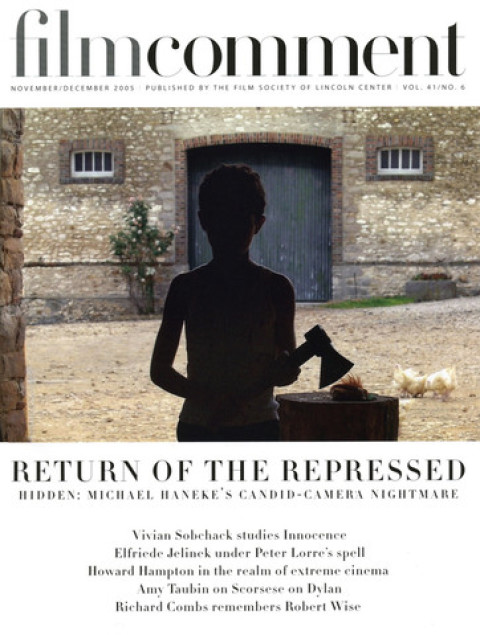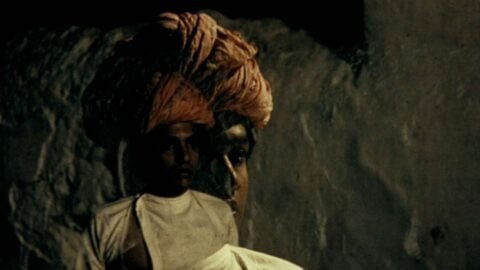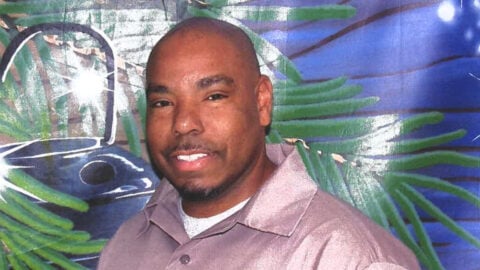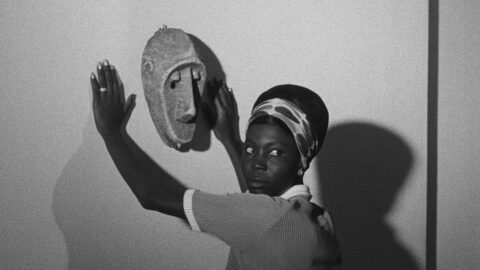
Two years ago, Morgan Fisher reappeared to the eyes and minds of cinephiles, after an absence whose length we’d more likely associate with comets or cicadas. The occasion was marked by the appearance of the curiously titled ( ). The eponymous parentheses double as an emoticon expressing the anticipation felt during the 19-year gap between its appearance and the filmmaker’s previous dispatch, the 1984 masterwork Standard Gauge. That film, whose sense of summation came to feel over time more like a finality, offered glimpses of a historical juncture within the motion picture industry overlaid with a chapter of Fisher’s own personal history.
Viewed as a whole, Fisher’s films are like a service entrance hidden behind the Hollywood sign, leading into corridors that take us past the film labs, sound stages, and utility closets of a vast movie empire. Viewed separately, they are sly and nuanced conundrums that introduce us to the unseen servants of an elaborate image-making process. Together, the films converse with and refer to one another in an intertextual cacophony worthy of Borges.
Early on in our study of film history, weíre taught that Gregg Toland’s cinematography in Citizen Kane (and, earlier, in John Ford’s The Long Voyage Home), with its greatly expanded depth of field, opened up revolutionary new fields of cinematic possibility. And if Toland’s approach represents a primary coordinate on a historical diorama, letís envision a line, represented by the zoom through Michael Snow’s loft in Wavelength, leading us to a second coordinate no less important, though far less familiar to most.
Confine the field of vision to a flat focal plane; lock the camera into a fixed position; choose an object, or maybe an image, to fill the frame. No montage, so long as there’s a hand to reach in and rearrange things when necessary. A recipe for tedium? Not for Fisher and a handful of his peers. P. Adams Sitney’s anointment of their body of work as “structural cinema” was confusing, and perhaps premature, given that it named a tendency that hadn’t fully taken shape yet. Perhaps it’s more useful to approach things from a materialist perspective, via the gear that transmitted their worldview. The copy stand, an embodiment of not only fixed immobility but the studio itself, is by its very limits the ideal vantage point for the scrutiny of a simple subject. Setting aside the particulars of its variants (tripod or other type of mount) and the orientation of its subjects (pinned to a wall, held in hand, lying on a table, burning on a hotplate), this was the common anchor for films as diverse as Hollis Frampton’s (nostalgia), Richard Serra’s Color Aid, and several of Fisher’s own works.
After earning an art history degree at Harvard in 1964, Fisher stayed on as a research assistant in the university’s early computer mapping efforts. Within a few years, he moved west for graduate work at USC and UCLA, where an interest in film took hold. Along with teaching, a series of jobs in Hollywood, yet off its beaten path—stock-footage research for Haskell Wexler’s aborted follow-up to Medium Cool, and editing for Roger Corman’s New World Pictures—provided a means for the first of his own forays into film. With their laconic titles, these early works—including The Director and His Actor Look at Footage Showing Preparations for an Unmade Film (68), and Documentary Footage (68)—tricked some into thinking that they were simply solipsistic exercises (given the degree of self-reflexivity within late Sixties and early Seventies art, perhaps this is understandable). David James once invoked the ouroboros in discussing Fisher’s Production Stills (70), and indeed, the mythical serpent devouring its own tail might well have served as an emblem to emblazon on the freak flag of late Modernist practice. But to what end did this alchemical circle close in upon itself? For Fisher, these films were zero-degree works, indicative not of the paralysis so prevalent then, but of a back-to-basics taking stock—“What is this thing called cinema, anyway?”
We might begin to answer this by looking at Phi Phenomenon (68), his most notoriously austere film. Evoking an endless afternoon study hall, the film consists of an 11-minute static (and silent) shot of a clock. The only visible movement is the creeping minute hand and the random effervescence of the black-and-white film grain. Seeing and knowing collide, as movement that barely qualifies as such is produced by a succession of nearly identical frames racing through the projector’s gate. The wall separating art and life is made uncomfortably flimsy, yet through their newly permeable boundaries our awareness of their difference is heightened.
By working through late Modernism’s cult of “essential properties” Fisher was fashioning his very own cinema of refusal: no editing (at least as it’s conventionally understood), no camera trickery, no sound dubbing, and an adherence to what his friend Thom Andersen (paraphrasing Lawrence Alloway) called “normal images.” It’s no surprise that two of his early films were included in the Museum of Modern Art’s landmark summit of conceptual art, the 1970 exhibition “Information.” Most important, though, was the audiovisual crossfire of his films, where the means of production became their putative subject. During these same years, the French critic Jean-Louis Baudry was publishing his early theoretical inquiries into the cinematic apparatus, working toward very different ends.
Fisher, like many of his contemporaries, embraced rule-based methods for his work. The Oulipo group, an international collective on a parallel track in the realm of experimental literature, also embraced arbitrary constraint as a means of creative liberation. The group posed their purpose as a definition, as recounted by member Jean Lescure: “Oulipians: rats who must build the labyrinth from which they propose to escape.” Understanding the inherent paradoxes further enriched the result, much as it did for Fisher. The rule to exhaust permutational possibilities between sound and image in Picture and Sound Rushes (73) was designed to comically undercut Fisher’s quasi-instructional efforts; a similar premise reappears in Projection Instructions (76), this time as both text and spoken commands for the projectionist to follow. Fisher has described the film itself as a score, which has elicited widely varying interpretations.
Standard Gauge (84) abandoned the absolute rigor of his previous films in favor of something looser, though no less thoroughly considered, in spirit reminiscent of a 19th-century scrapbook. It stands as a temporal repository of discarded film stock (sometimes single frames) to which Fisher had a personal connection and deep emotional attachment, belied by the measured tone of his narration. Toward the beginning, Fisher confides, “I’ve never seen a piece of 35 that I didnít want to pick up and look at.” The pleasures of this tactile connection to beauty, to craft, and to history are nowhere clearer than when a fragment of Hindenburg footage appears midway through the film. Not only does it forge a link to Bruce Conner’s A Movie, in which the dirigible also appears (and about which Fisher has expressed great ambivalence), it also calls forth a fetishistic awe at the association, unstated yet undeniably present, between the airship it depicts and the nitrate stock on which its image was captured, ready to combust with just an errant spark. Standard Gauge is laced throughout with a sense of loss, whether it’s the ephemerality of film stock, a missed opportunity at B-movie stardom, or the closing of an IB Technicolor printing plant in Hollywood, victim to economic forces that outsourced the work to China. Toward the end Fisher says, “Here are some pieces of film that I think are interesting to look at.” What follows is a tender coda: miscellaneous frames pass before us in reverential silence. That closing sentiment set out the premise for ( ), a very different type of found-footage film, drawing from dozens of features rendered more or less anonymous by the guiding limitation: only close-up insert shots are used. On the surface, it’s unlike anything Fisher’s ever produced. But wait: inserts are the onscreen counterparts to the unsung subjects that Fisher has always favored; they are, as he wrote in an accompanying statement, “far from the traffic in faces and bodies … that are the heart of narrative film … [T]hey have a job to do and they do it.” Guns predominate, and clocks and watches run a distant second. These close-ups without stars are sequenced to follow a predetermined rule, though all we know of it is that no two inserts from the same film appear consecutively to one another (though sometimes they’re separated by just one shot). In certain passages, we’re teased by intermittent patterns that suggest a cross-cutting that predates Griffith.
So here again are an arbitrary set of constraints. What’s different this time is that they’re hidden, in order to “liberate the inserts from their stories. The shots are raised from necessity to freedom.” Over the course of the film, we realize that narrative (even a radically reconfigured one) has been thwarted, so we look for other types of order. Weíre now in unfamiliar territory, and this new freedom, in turn, serves up a whole new paradox: even as ( ) adheres to its own course, each insert generates an imaginary follow-through to the actions and gestures it depicts. Between these two movements, waves of association collide. As Fisher’s films often proceed directly from the consequences of their immediate predecessors, are these stray signals of his next step forward?








